Excerpts from Jim Conrad's
Naturalist Newsletter
from the May 12, 2013 Newsletter issued from the Frio Canyon Nature Education Center in northern Uvalde County, southwestern Texas, on the southern border of the Edwards Plateau; elevation ~1750m (~5750 ft); N29.62°, W99.86°; USA
MESQUITES FLOWERING
At this time of year the Mesquites, PROSOPIS GLANDULOSA*, lend a special touch of grace to the landscape with their elegant low, widely spreading shapes, the way wind and sunlight mingle so congenially inside their airy interiors, and the surprising emerald greenness of their new leaves. In this landscape otherwise dominated by dark, hard hues of oak and juniper. Below you can see the interior pleasing branching of a Mesquite in my backyard:
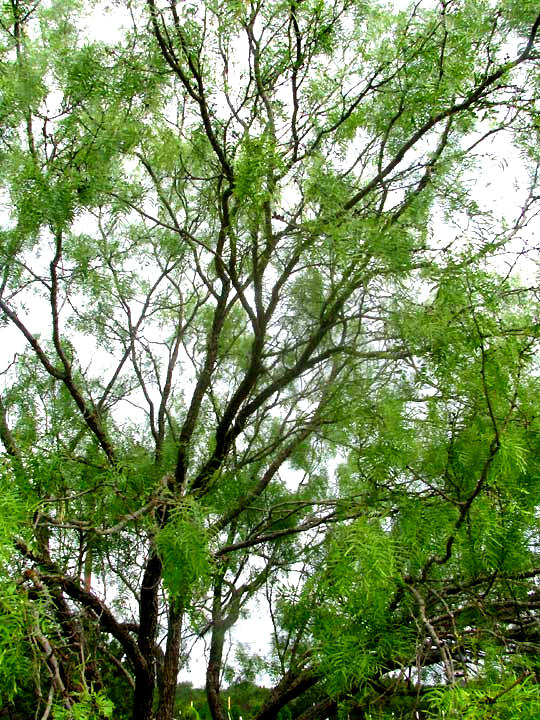
Up closer you can see the Mesquite's twice-compound leaves structured like two feathers joined at their bases atop a single arching petiole:
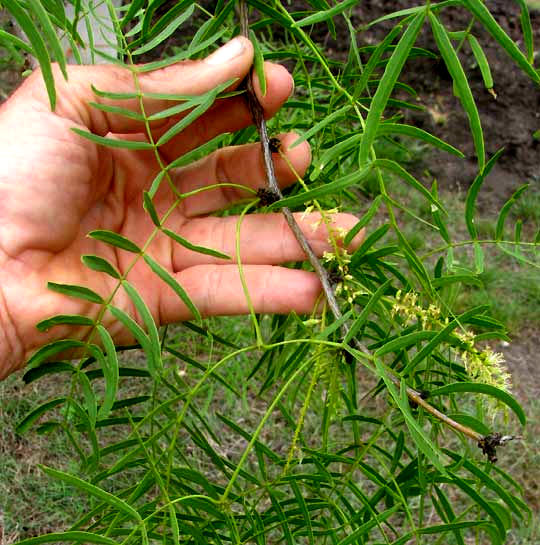
That picture also shows yellowish spikes of tiny flowers among the leaves. A close-up of some flowers whose petals are only about 1/8th inch long (3mm) is shown below:
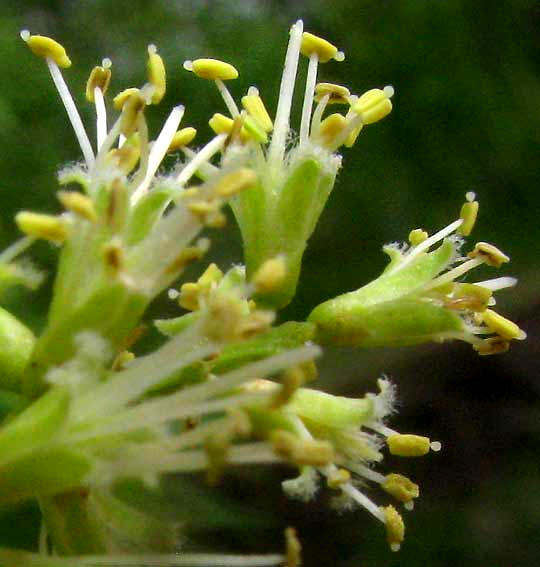
It's interesting to note the hairiness at the tips and margins of the petals, possibly providing pollinators footholds as they wander over the blossoms looking for nectar. A feature of the flowers that surprised me when I saw the above picture is that many of the yellow, hotdog-bun-shaped, pollen producing anthers bear tiny, white, globular items at their tips. These items were so unexpected that I had to snip off a flower and look at its anthers under our dissecting scope. You can see what I found below:
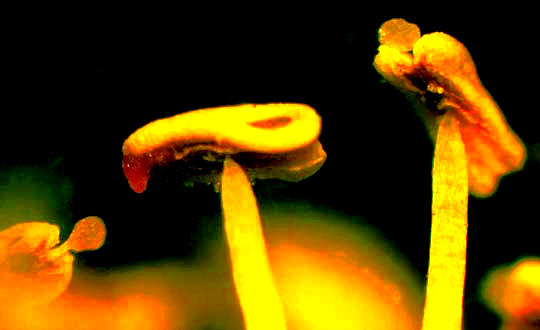
The spherical items are glands. A study found that inside active glands secretory cells degenerate to release a protein carbohydrate exudate, which passes through openings of the gland's surface. The nutritious exudate spreads across the glands' surfaces attracting foraging insects, which provide the tree pollination service.
Here in the southwestern Texas Hill Country Mesquites aren't nearly as abundant as they are in drier landscapes to our south and west. There sometimes you see nearly pure stands of Mesquite stretching horizon to horizon. Here some landowners complain about Mesquite encroaching on their ranches, thinking of the tree as a scrubby, desert species. In fact, Mesquites may be invading our area because global warming is making our arid land even drier, enabling the vast Chihuahuan Desert to our west slowly to expand toward us. Maybe Mesquites are harbingering what's to come.
Old-timers here also know that Mesquite makes good firewood, is excellent for making charcoal, and that fine fence posts can be made from them.
Mesquite leaves contain tannins, so traditionally they've been dried and made into powder to apply to cuts and scrapes to cut down on inflammation and to pucker cut veins so they don't bleed so much. Mesquite leaf tea has been used against sunburn, rashes, bites and other such skin irritations, and can be gargled for a sore throat and mouth sores.
from the June 29, 2014 Newsletter issued from the Frio Canyon Nature Education Center in the valley of the Dry Frio River in northern Uvalde County, southwestern Texas, on the southern border of the Edwards Plateau; elevation ~1750m (~5750 ft); N29.62°, W99.86°; USA
MESQUITES FRUITING
Nowadays handsome fruits dangle from our Mesquites, and since Mesquites belong to the big Bean Family, the fruits are legumes, and the seeds inside the legumes are beans. Below, you can see some green-bean-like legumes.
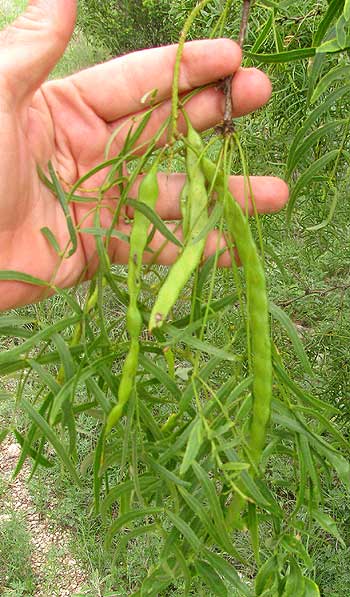
Later the legume will ripen into a light tan or brown pod, and in the old days that pod was eaten. The seeds, or beans, become hard when dry but the whole pod -- skin, beans, and material between the beans -- is edible when ground into meal from which biscuits or pancake-like affairs can be made. Remains of Mesquite fruits and beans have been excavated in many archaeological sites.
The soft matter around the hard seeds -- the seed mesocarp -- contains about 32% sugars and 7% protein. When seeds are included in the grinding, the flour can contain 29-39% protein. But those hard, small seeds are hard to process and are themselves indigestible.
In fact, among folks of the raw food/vegan community, Mesquite flour sometimes is hyped as a "superfood." You can see how it's presented on a commercial webpage selling it for $9.95 per 16-oz. bag here.